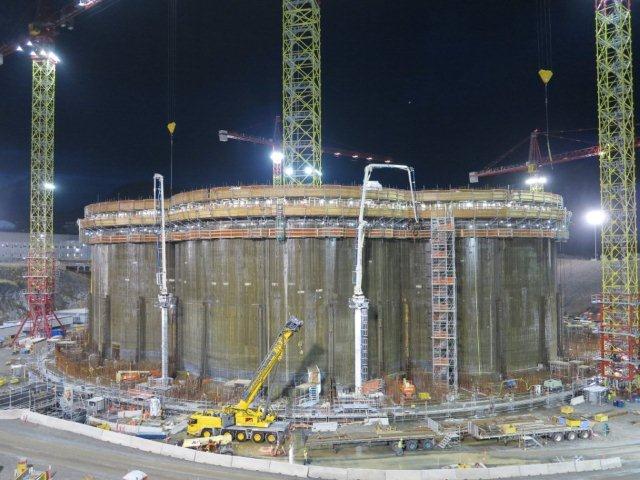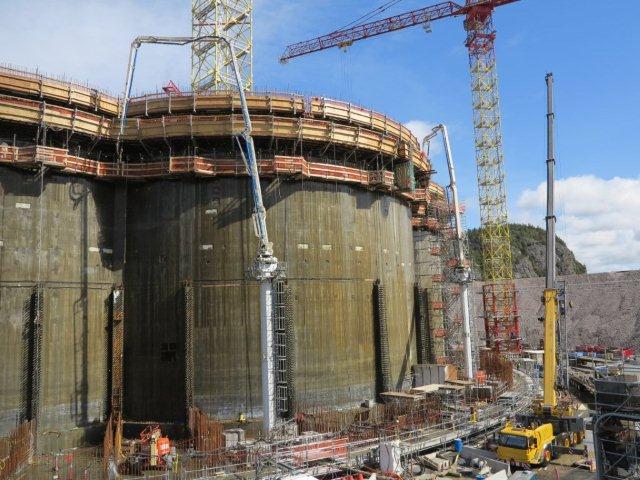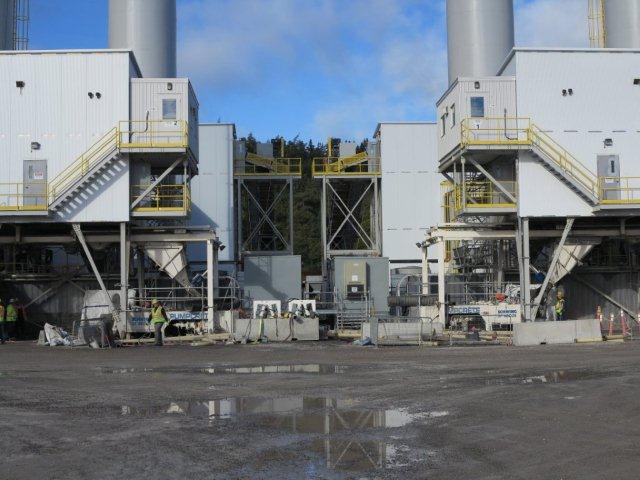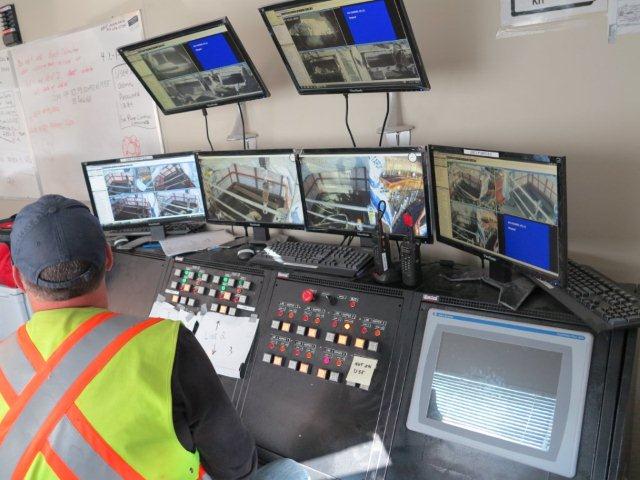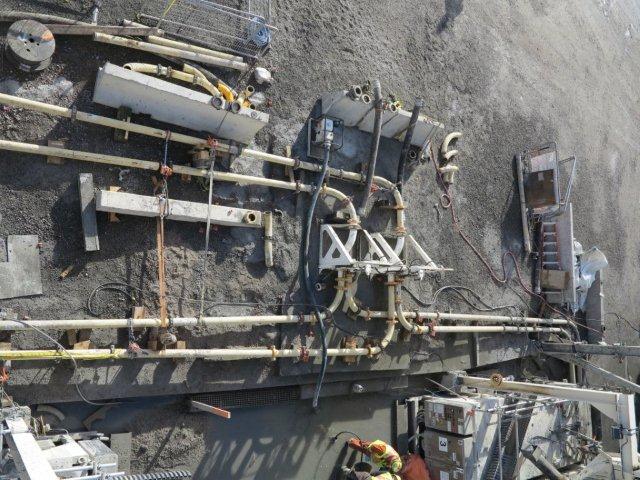Automated Pumping Creates an Off-Shore Oil Well Platform

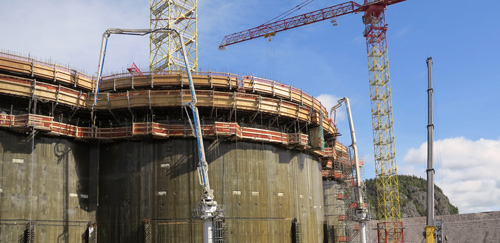
Pumpcrete, Toronto, Canada is pumping their second concrete Gravity Base Structure (GBS) that will eventually provide the foundation for an oil well platform in the Atlantic Ocean. Pumpcrete’s expertise on engineered projects, including the Hibernia Oil Well Platform constructed in the early 90s, made them a natural choice for this project. “We were specifically requested by one of the contractors who had worked with us in the past, “ according to Dave Moriarty, Pumpcrete’s pump manager. This current GBS has required massive amounts of pumped concrete with distribution choreographed by an automated system designed by Pumpcrete. “When you take on projects like these you want to have reliable equipment,” Ken Williams Jr. Pumpcrete’s president noted.
Located in the Atlantic coastal area of Newfoundland and Labrador, Bull Arm is the fabrication site for the GBS. The dry dock facilities are adjacent to a man-made earthen barrier that will be removed to flood the construction site and float the gigantic structure into deep water. Pumpcrete designed an innovative pumping and placing system around Schwing equipment that has kept the project on schedule with very little maintenance. After initial construction of the 130-meter diameter base for the structure, the automated pumping system has meant that Moriarty is the only Pumpcrete person required on-site. “Many of the contractor’s crew were on the Hibernia project, so they know the routine when it comes to concrete pumping with an automated system,” Moriarty explains.
The 130-meter diameter base was constructed in May 2013 and consisted of four 5,000 cubic meter pours executed by two Schwing S 61 SX concrete pumps and two separate placing booms. The truck-mounted units were positioned strategically to cover part of the circular base with their 198-foot reach and the free-standing 35-meter separate placing booms covered the rest. Because the four Schwing SP 4800 stationary concrete pumps were located under the onsite batch plant 150-meters from the GBS, four 125-mm lines connected the stationary pumps to the placing equipment. The pipeline was connected directly to the deck pipe on the S 61 SXs and the concrete was placed with the truck-mounted units’ booms. All four of the base pours were accomplished in three days.
The 35-meter separate placing booms, detached from Pumpcrete’s S 39X Schwing truck-mounted pumps, continue to provide an important connection to the slipforming of a central shaft and seven cells that will make up the GBS. As the forms rise, the 4-section booms accommodate the movement. Flexible hoses on the end of the booms plug into the pipeline that feeds seven hoppers located on the three-tiered slipform system. The booms are free standing on 12-meter octagonal masts that are mounted on ballasted cross frames. The octagonal system is modular with 6-meter sections that are bolted together allowing for easy transport to the site. Ladders, pipeline holders and work platforms can be easily added thanks to brackets welded on each mast section.
The slipforming process is an automated system. One of the booms feeds a pipeline connected to four hoppers located on the slipform platform, the other boom feeds three. As the slipform rises, cameras monitor the levels in the pump hoppers at the batching site and the hopper levels on the slipform. Floats in the large hoppers on the rising forms can shut off the flow and divert the mix to other hoppers surrounding the pour area. A control panel allows one operator to monitor and control the entire operation with diversion valves, batching output and pumping speed. Laborers fill buggies from the form-mounted hoppers and dump it into the climbing system for a continuous, controlled pour. Over a 20-day period the form rose 27-meters with non-stop concrete pumping.
The mix used on the project contains a “very abrasive” 12-mm granite aggregate mined on site. The resulting 80-mpa mix is pumped at 240 mm slump. In order to provide setting time during the slipform process, the mix is “Loaded with retarder to provide a 16-18-hour setting time,” according to Moriarty. A test conducted before the actual pumping required that the mix sit in the delivery line for two hours and still remain pumpable. “When we started pumping again there was only a difference of 20 bar in pumping pressure,” according to Moriarty.
Schwing specially designed the SP 4800s with dual 150 kW electric motors and hydraulic pumps for complete redundancy so that pumping would remain continuous in the event of a problem. None has occurred in the 20 plus days of pumping the original 27-meters of vertical concrete construction. The Pumpcrete SP 4800 electric skid-mounted stationary pumps are equipped with 2020-5 130/80 MPS pump kits with 8” x 79” material cylinders. The modified high-pressure Rock Valves are equipped with axial bearings and carbide wear parts to cope with the pumping pressures and abrasive mix. They also operate with biodegradable hydraulic oil required for use in marine applications.
The GBS will eventually reach a height of 120-meters but the next phase of the slipforming will take place in deep water. The entire array of batching and pumping equipment will be loaded on barges and the flotilla will join the GBS at a deepwater site one kilometer off shore. Here the slipforming will continue and the GBS will be simultaneously ballasted to keep the freeboard at the same height. “Other than the logistics of being at sea, the process is the same without the placing booms,” Dave notes. A pipeline scissors arrangement will be used for the hard pipe connection at the forms. Pumpcrete is exploring different methods of the final ballasting, “It looks like our S 61 SX could be lifted onto a wall that would fit the outrigger spread perfectly, “ Moriarty said.
The final concrete tally once the GBS is completed, with a slipformed shaft to support the topside structure, will be 132,000 cubic meters. The topside structure with offices, drilling equipment and accommodations for 200 workers is 158 x 64-meters and weighs 65,000 tons. Once the GBS is completed, the topside structure will be attached and the entire assembly will be towed to the Grand Banks 350-kilometers from the Bull Arm assembly point where it will be sunk in 93-meters of water. Oil extraction is scheduled to begin in 2017.
Specs:
Project: Oil Well Platform
Contractor Pumper: Pumpcrete, Toronto, Canada
Equipment: Two Schwing S 61 SX truck-mounted concrete pumps, two 35-meter placing booms detached from Schwing S 39X truck-mounted concrete pumps, two 12-meter octagonal masts with ballasted cross-frames and four Schwing SP 4800 electric powered stationary pumps.



